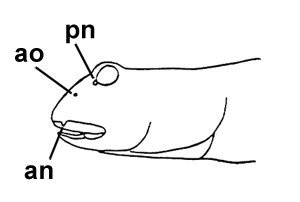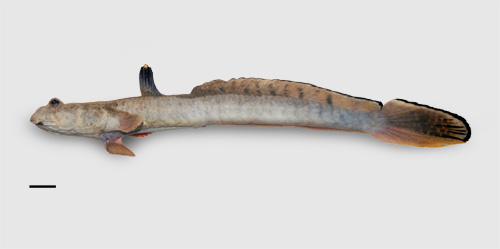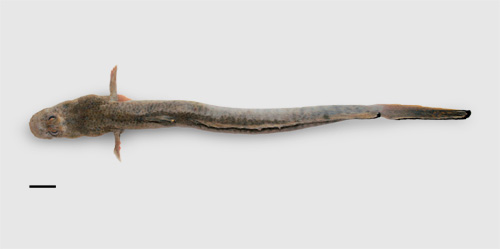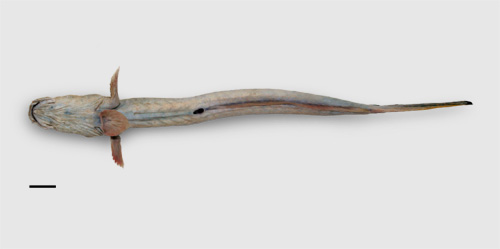Common names:
China |
Chinese Mandarin |
細青彈塗魚, 细青弹涂鱼 (Xi qing tan tu yu - Small green mudskipper) |
Finland |
Finnish |
Persianviiriryömijä |
Italy |
Italian |
Saltafango tigrato* |
Oman |
English |
Slender mudskipper |
UK |
English |
Indian Ocean slender mudskipper |
* proposed name
|
|
|
Synonyms:
Boleophthalmus tenuis |
Day, 1876 |
(senior synonym) |
Scartelaos tenuis |
(Day, 1876) |
(senior syn., new combination) |
Etymology:
'Scartelaos' is probably a compound name from the Greek 'skarthmos' (leaping), and 'laos' (people, folk), which maybe refers to
the typical tail-stand of males during courtship
'tenuis' means 'thin' in Latin, which refers to the slenderness of this mudskipper
|
Maximum recorded length:
155 mm SL (Randall, 1995)
190 mm TL (Abdoli et al., 2009)
Live colouration (Murdy, 1989, pers. obs.: Iran):
ground colour on dorsum and flanks light brown to light grey: dorsally darker; venter whitish; head and dorsum with dark grey to brownish mottling, which become larger posteriorly; dark grey blotches may be present posteriorly on flanks. D1 bluish grey with an orange tip in some specimens; D2 dusky to yellowish grey with grey blotches posteriorly and a black margin, posteriorly more intense; an inframaginal white stripe may be present; caudal fin
orange in the background, dark grey in the middle with orange ocular spots and a dorsal black margin;
an inframaginal white stripe may be present; anal, pectoral and pelvic fins greyish to fleshy; pectoral fins with small dark grey spots
Colouration on preservation (Murdy, 1989,
pers. obs.: Iran):
ground colour bluish grey to brownish, ventrally paler; several dark bars on trunk may be visible; numerous dark spots may be visible on nape, cheeks, opercula, and pectoral fins; D1 paler basally; a white spot may be present on top; D2 speckled, with a black dorsoposterior margin and large, dark spots posteriorly; caudal fin with a black dorsoposterior margin with ocular spots; anal and pelvic fins hyaline
Diagnosis (Murdy, 1989):
head depth 9.5-10.8%SL; caudal fin length 21.7-26.3%SL; length of D1 base 5.6-8.3%SL; D2 and anal fins
not connected by membrane to the caudal fin; no barbel near the symphysis of lower jaw;
15-18 vertical dark bars on flanks; large, dark spots or stripes basally on D2.
The genus is characterised by the presence of barbels on the ventral surface of the
head
Diet:
no published study is available
|
Reproduction:
no published study is available
|
|
|
|
Ecological notes (pers. obs.: Iran):
adults locally very abundant on lower and higher mudflats, wherever semi-liquid mud is present; some notes on the ecology and behaviour
of this species are also present in Clayton & Vaughan, 1986
(= S. viridis). Recently, a population of this species was found to be parasitised by a leech (Zeylanicobdella arugamensis, Piscicolidae)
in southern Iran by Polgar et al. (2009).
middle: Bandar Khamir, Hormozgan, Iran: a tidal mudflat exposed at low tide, ranging from a supratidal sand dune to the sea; S. tenuis adults were abundant
here, from a distance of about 250 m from the sand dune
(photo: G. Polgar, 2007) |
|
|
|
Distribution:
from Persian Gulf to Pakistan; type locality: Karachi, Pakistan
(Murdy, 1989)
|
|
Photographs of Scartelaos tenuis:
|
A: S. tenuis
fixed and preserved in formalin (photo: G. Polgar, 2007); B-C: close-up of a specimen in laboratory (photo: G. Polgar, 2007); D: another close-up in aquarium (photo: G. Polgar, 2007); E: a specimen on a tidal mudflat (photos A-E: G. Polgar, Bandar Abbas, Hormozgan, Iran, 2007); F: two specimens on a tidal mudflat (photo: D. Clayton, Kuwait) - * with permission
|
Drawings of Scartelaos tenuis:
 A
|

B
|
A: cephalic sensory and nasal pores of Scartelaos spp.: an= anterior nostril;
ao= anterior oculoscapular canal pore; pn= posterior nostril (modified from
Murdy, 1989)*; B: Boleophthalmus tenuis Day (Day, 1876) - * with permission
|








